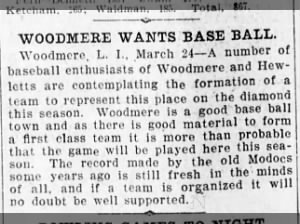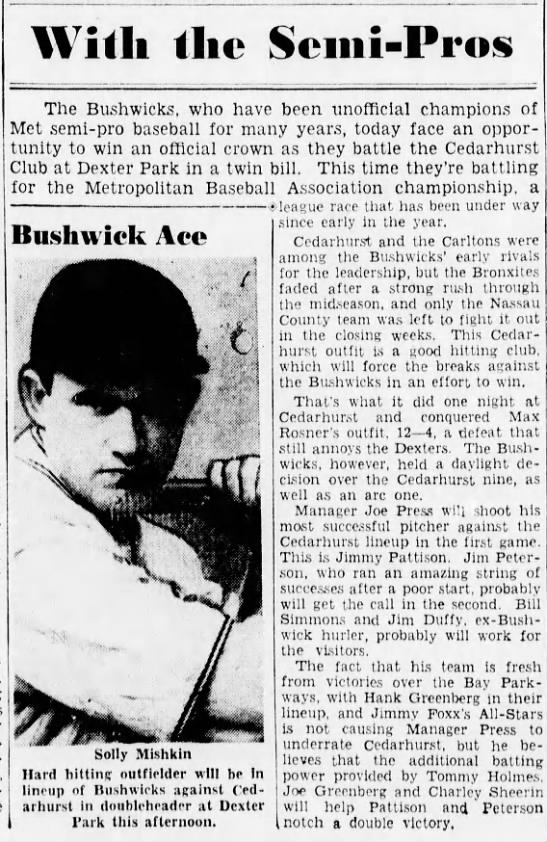
By the 1870's,Woodsburgh had become a popular summer vacation destination and the community formed a team - both for their own pleasure and the entertainment of vacationers. The Modocs (named for a Native American tribe) were respected competitors and their principal rivals were the Nationals of Pearsalls (today's Lynbrook), the Colonials of Far Rockaway and the Unions of East Rockaway.
 |
| Brooklyn Daily Eagle, September 3, 1895, p. 7 |
 |
| Brooklyn Daily Eagle, March 24, 1904, p.8 |
In 1889, several amateur teams began to explore the possibility of forming a league. By 1899, six teams, including Freeport, Hempstead, Valley Stream, Rockville Centre and Wantagh combined to form the South Side League. Baldwin and Amityville soon joined, but the Woodmere team did not apply for membership. However, in 1903, the Cedarhurst team did apply and by 1905, the team proved a formidable opponent in the league.
 |
| Brooklyn Daily Eagle, March 30, 1905, p. 11 |
1900
In 1909, philanthropist Olivia Sage (Mrs. Russell Sage) purchased the Cedarhurst baseball grounds in 1909, for the purpose of erecting affordable housing for working people. The Cedarhurst Field Club, which had been formed in 1903 played under the management of Thomas J. Brown of Cedarhurst. Samuel
N. Hinckley (1881-1931) eventually a Harvard-educated stock broker and real estate
investor, spent three years playing first base with the Cedarhurst semi-professional team. Cedarhurst Justice of the Peace Lewis Raisig often served as umpire. The team played home games at the Nassau Trade School Field on Lawrence Avenue in Lawrence on Saturdays and holidays until the construction of a new field on Fifth Avenue between Rockaway Turnpike and Washington Avenue in 1915. Away games were played on Sundays. (BDE, 6/1/1913, p.11) In 1914, Cedarhurst played Inwood for the Championship of the Rockaway Branch.
( BDE 9/16/1914, p. 8)
 |
| Brooklyn Daily Eagle, May 20, 1915 – Page 9 |
The "Dead-Ball Era" is the sobriquet usually given to the years between 1900 and 1919, a time of low scoring games. One source elaborates:
For amateur and semi-professional teams, the conditions must have been even worse.The term also accurately describes the condition of the baseball itself. Baseballs cost three dollars apiece, a hefty sum at the time, which in 1900 would be equal to $85 today; club owners were therefore reluctant to spend much money on new balls if not necessary. It was not unusual for a single baseball to last an entire game. By the end of the game, the ball would be dark with grass, mud, and tobacco juice, and it would be misshapen and lumpy from contact with the bat. Balls were only replaced if they were hit into the crowd and lost, and many clubs employed security guards expressly for the purpose of retrieving balls hit into the stands—a practice unthinkable today.
As a consequence, home runs were rare, and the "inside game" dominated—singles, bunts, stolen bases, the hit-and-run play, and other tactics dominated the strategies of the time.
In 1937, Max Rosner, owner of the Brooklyn Bushwicks and Bill Leuschner of Nat Strong, Inc., organized the Metropolitan Baseball Association for semi pro teams in the Greater New York Area. To qualify, teams had to have a quality home field with lights for night games. Because of the ban on night games during World War II, the association was suspended, but re-formed in 1946. (Kroessler, p. 125-6.)
The Cedarhurst Municipal Stadium was located near the intersection of Peninsula Boulevard and Rockaway Turnpike, on the site of today's Lawrence Senior High School. It was built by the Village of Cedarhurst in 1937 with workers furnished by the WPA.
Between 1937 and 1941, it hosted semi-professional Metropolitan Baseball League teams, including the New York Black Yankees and the Brooklyn Royal Giants of the Negro National League. Negro League baseball stars like Marion "Sugar" Caine and Barney Brown played at Cedarhurst during the 1939 season.
The home team was the Cedarhurst Cedars.
As a young man, Bert Moser played in the minor leagues for a short time.
"Born on August 6, 1918 in Cedarhurst, he spent his early years watching the teams at Cedarhurst Stadium. According to Bert, they played some of the best teams in their class such as the Bushwicks, House of David, Detroit Clowns, Black Yankees or Giants, Cuban All Stars and Springfield Grays. He would stand out there with a little mitt on Sunday afternoon catching balls, and when the game started sneak up into the stands or sell peanuts."
(Interview with Bert Moser, Society for American Baseball Research website)
 |
The Brooklyn Daily Eagle, 16 Oct 1938,, Page 39 |
Further information

